BAC221 Business Finance: Investment Decisions & Cost Analysis
VerifiedAdded on 2023/03/23
|5
|636
|29
Homework Assignment
AI Summary
This assignment provides solutions to two questions related to business finance. The first question involves evaluating a replacement project for Thin Fabrications Pty Ltd, focusing on incremental cash flows, NPV, IRR, and profitability index to determine if a manually operated machine should be...
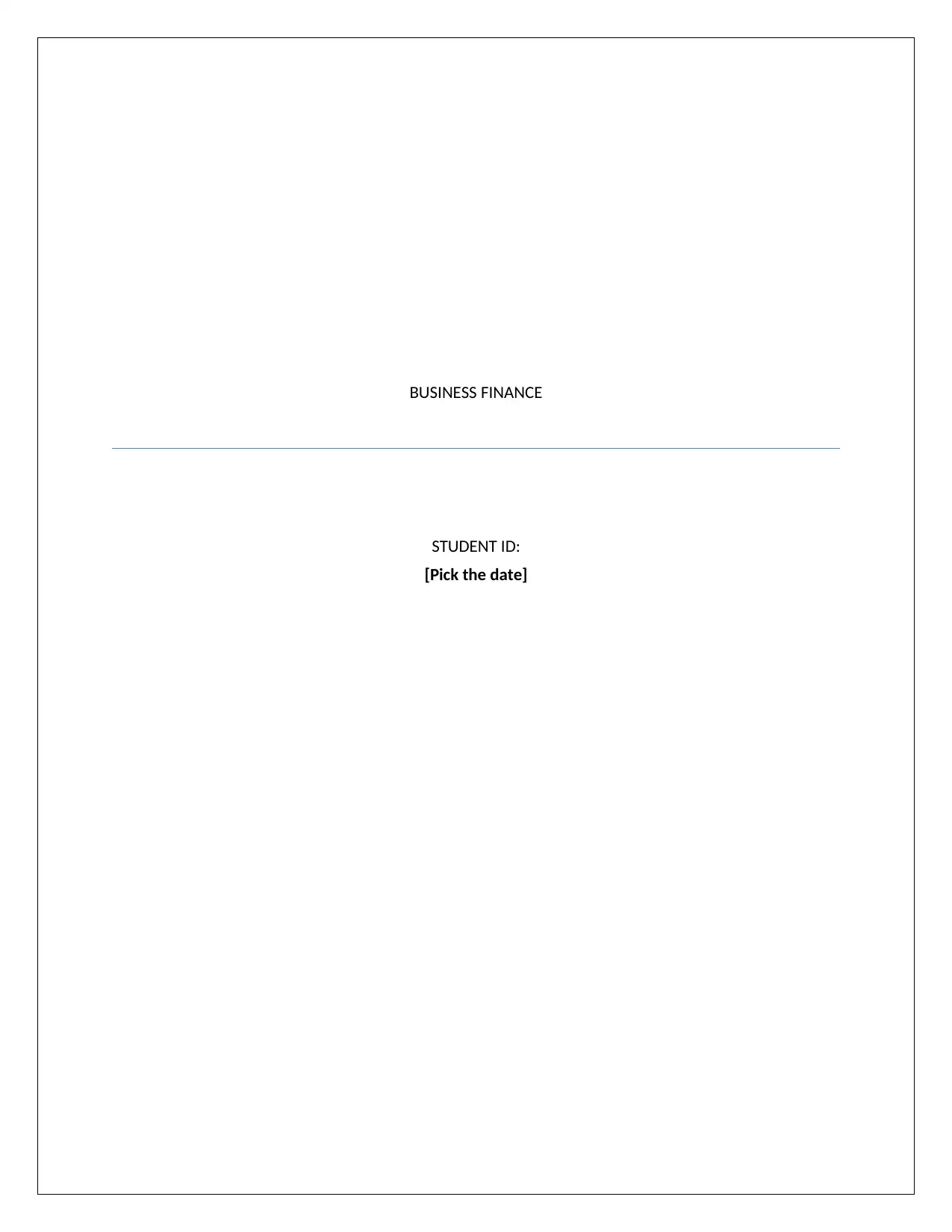
BUSINESS FINANCE
STUDENT ID:
[Pick the date]
STUDENT ID:
[Pick the date]
Paraphrase This Document
Need a fresh take? Get an instant paraphrase of this document with our AI Paraphraser
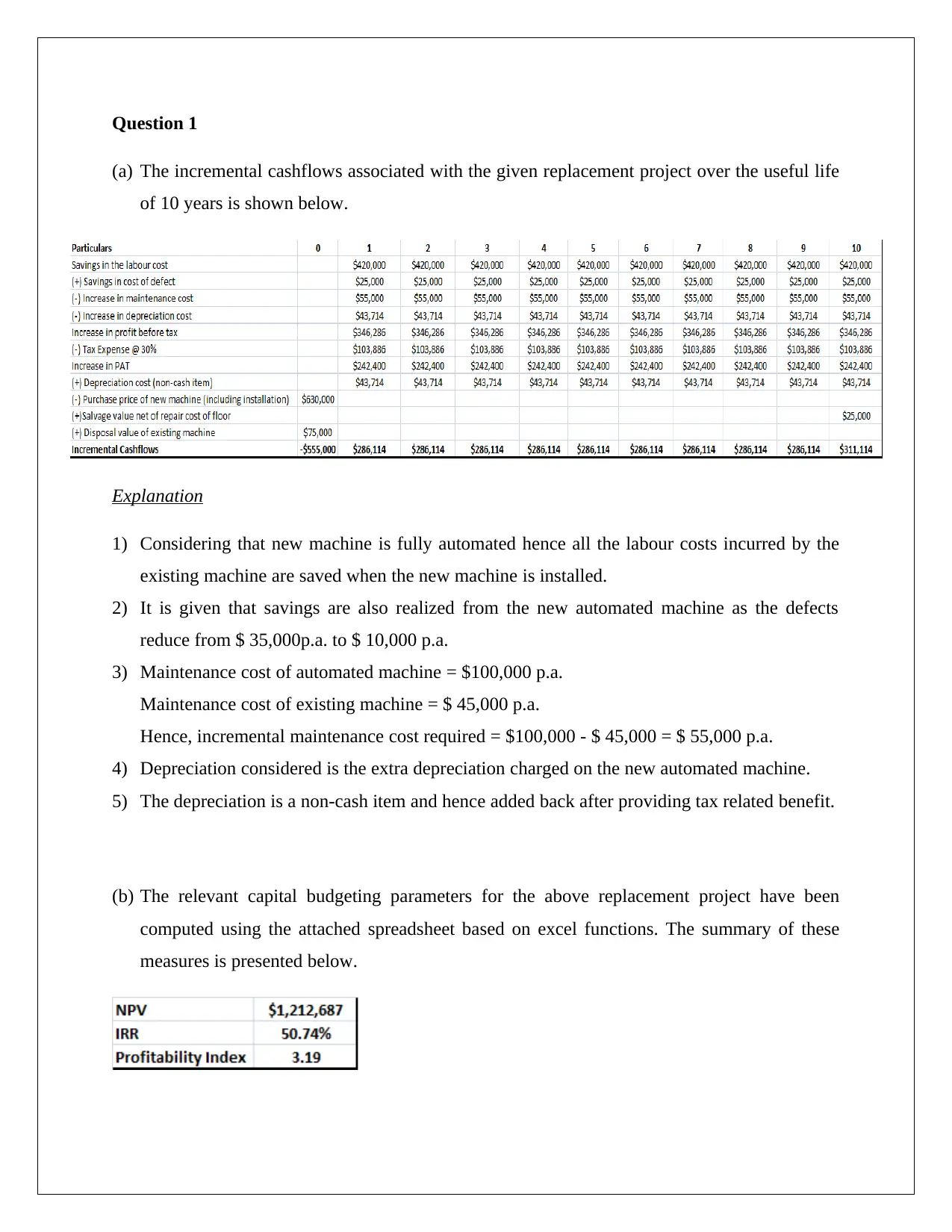
Question 1
(a) The incremental cashflows associated with the given replacement project over the useful life
of 10 years is shown below.
Explanation
1) Considering that new machine is fully automated hence all the labour costs incurred by the
existing machine are saved when the new machine is installed.
2) It is given that savings are also realized from the new automated machine as the defects
reduce from $ 35,000p.a. to $ 10,000 p.a.
3) Maintenance cost of automated machine = $100,000 p.a.
Maintenance cost of existing machine = $ 45,000 p.a.
Hence, incremental maintenance cost required = $100,000 - $ 45,000 = $ 55,000 p.a.
4) Depreciation considered is the extra depreciation charged on the new automated machine.
5) The depreciation is a non-cash item and hence added back after providing tax related benefit.
(b) The relevant capital budgeting parameters for the above replacement project have been
computed using the attached spreadsheet based on excel functions. The summary of these
measures is presented below.
(a) The incremental cashflows associated with the given replacement project over the useful life
of 10 years is shown below.
Explanation
1) Considering that new machine is fully automated hence all the labour costs incurred by the
existing machine are saved when the new machine is installed.
2) It is given that savings are also realized from the new automated machine as the defects
reduce from $ 35,000p.a. to $ 10,000 p.a.
3) Maintenance cost of automated machine = $100,000 p.a.
Maintenance cost of existing machine = $ 45,000 p.a.
Hence, incremental maintenance cost required = $100,000 - $ 45,000 = $ 55,000 p.a.
4) Depreciation considered is the extra depreciation charged on the new automated machine.
5) The depreciation is a non-cash item and hence added back after providing tax related benefit.
(b) The relevant capital budgeting parameters for the above replacement project have been
computed using the attached spreadsheet based on excel functions. The summary of these
measures is presented below.
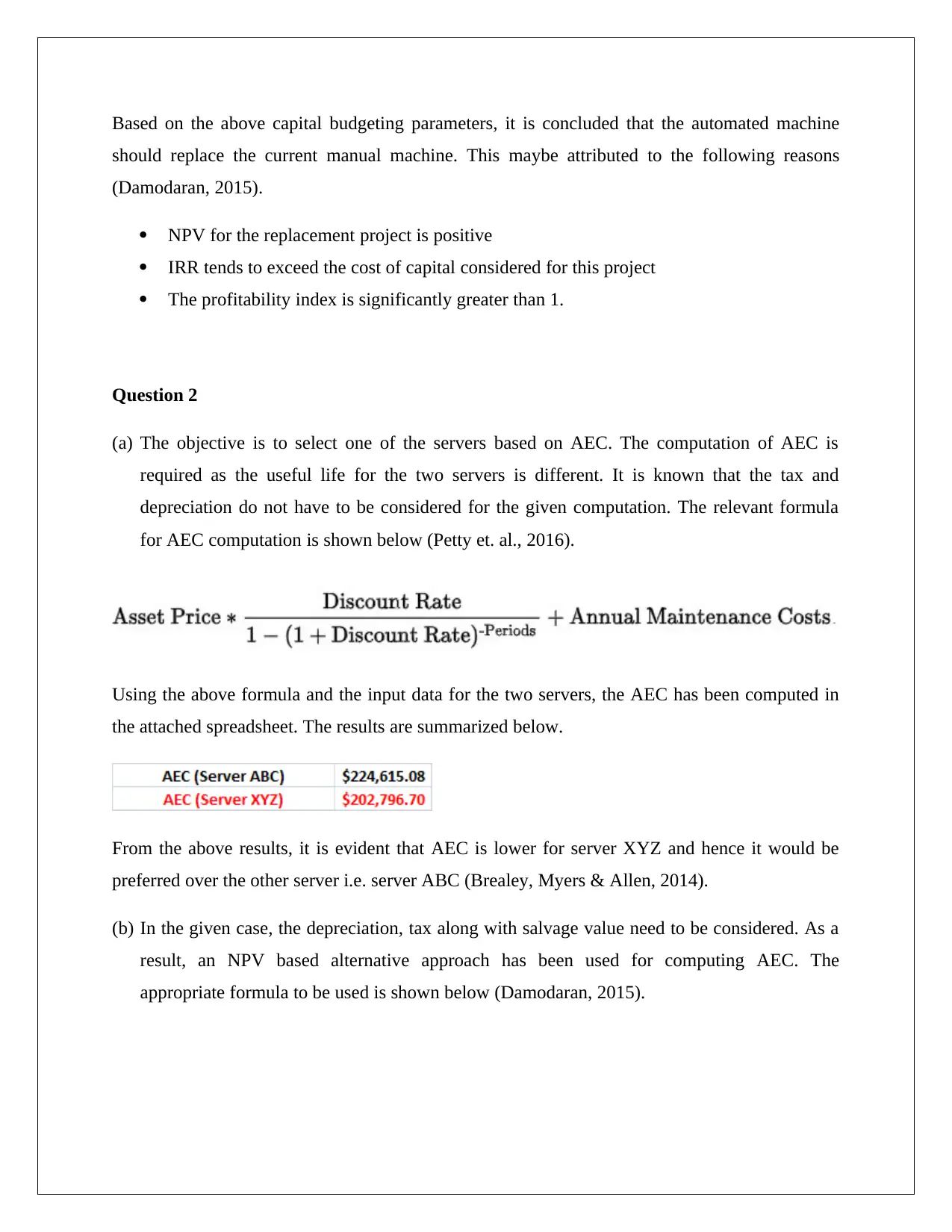
Based on the above capital budgeting parameters, it is concluded that the automated machine
should replace the current manual machine. This maybe attributed to the following reasons
(Damodaran, 2015).
NPV for the replacement project is positive
IRR tends to exceed the cost of capital considered for this project
The profitability index is significantly greater than 1.
Question 2
(a) The objective is to select one of the servers based on AEC. The computation of AEC is
required as the useful life for the two servers is different. It is known that the tax and
depreciation do not have to be considered for the given computation. The relevant formula
for AEC computation is shown below (Petty et. al., 2016).
Using the above formula and the input data for the two servers, the AEC has been computed in
the attached spreadsheet. The results are summarized below.
From the above results, it is evident that AEC is lower for server XYZ and hence it would be
preferred over the other server i.e. server ABC (Brealey, Myers & Allen, 2014).
(b) In the given case, the depreciation, tax along with salvage value need to be considered. As a
result, an NPV based alternative approach has been used for computing AEC. The
appropriate formula to be used is shown below (Damodaran, 2015).
should replace the current manual machine. This maybe attributed to the following reasons
(Damodaran, 2015).
NPV for the replacement project is positive
IRR tends to exceed the cost of capital considered for this project
The profitability index is significantly greater than 1.
Question 2
(a) The objective is to select one of the servers based on AEC. The computation of AEC is
required as the useful life for the two servers is different. It is known that the tax and
depreciation do not have to be considered for the given computation. The relevant formula
for AEC computation is shown below (Petty et. al., 2016).
Using the above formula and the input data for the two servers, the AEC has been computed in
the attached spreadsheet. The results are summarized below.
From the above results, it is evident that AEC is lower for server XYZ and hence it would be
preferred over the other server i.e. server ABC (Brealey, Myers & Allen, 2014).
(b) In the given case, the depreciation, tax along with salvage value need to be considered. As a
result, an NPV based alternative approach has been used for computing AEC. The
appropriate formula to be used is shown below (Damodaran, 2015).
⊘ This is a preview!⊘
Do you want full access?
Subscribe today to unlock all pages.

Trusted by 1+ million students worldwide
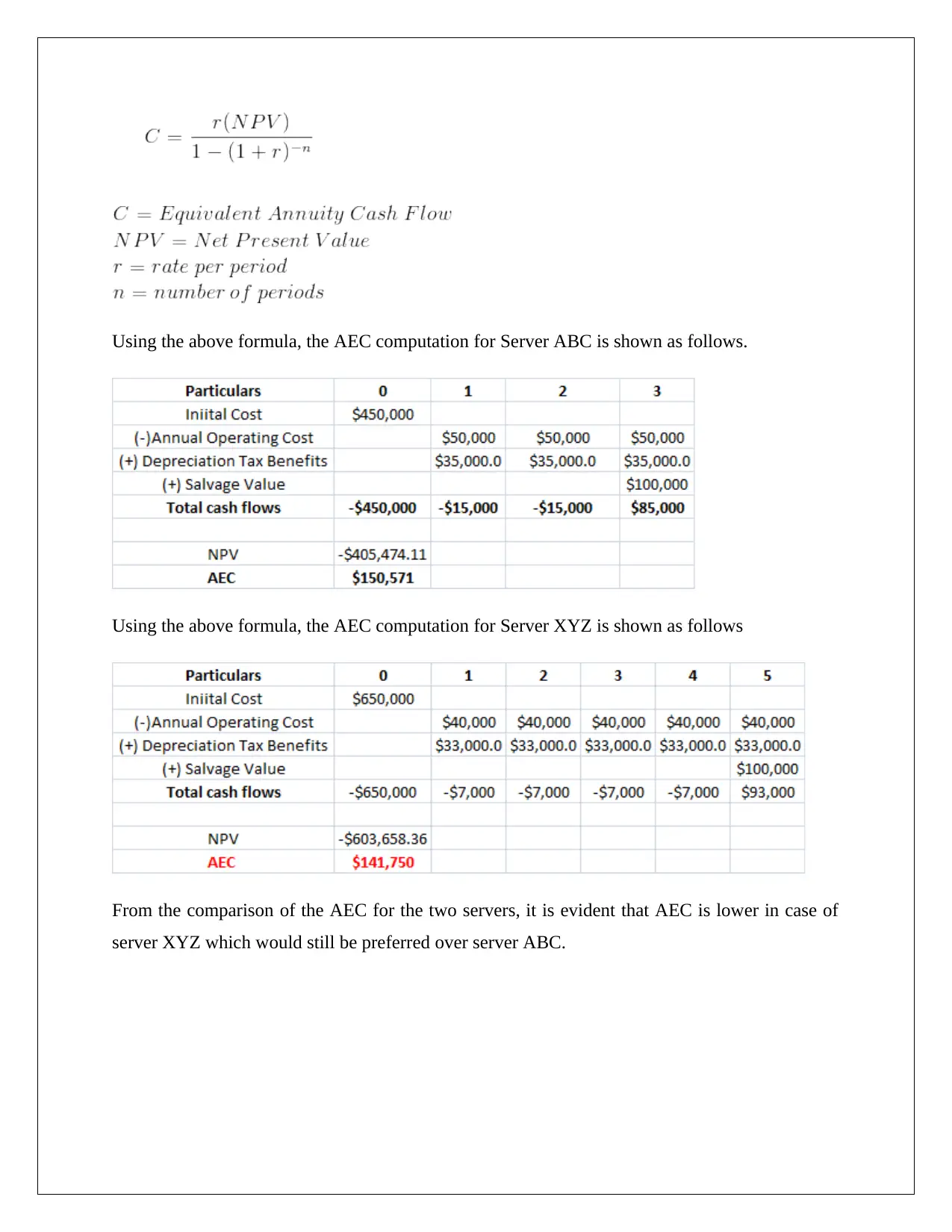
Using the above formula, the AEC computation for Server ABC is shown as follows.
Using the above formula, the AEC computation for Server XYZ is shown as follows
From the comparison of the AEC for the two servers, it is evident that AEC is lower in case of
server XYZ which would still be preferred over server ABC.
Using the above formula, the AEC computation for Server XYZ is shown as follows
From the comparison of the AEC for the two servers, it is evident that AEC is lower in case of
server XYZ which would still be preferred over server ABC.
Paraphrase This Document
Need a fresh take? Get an instant paraphrase of this document with our AI Paraphraser
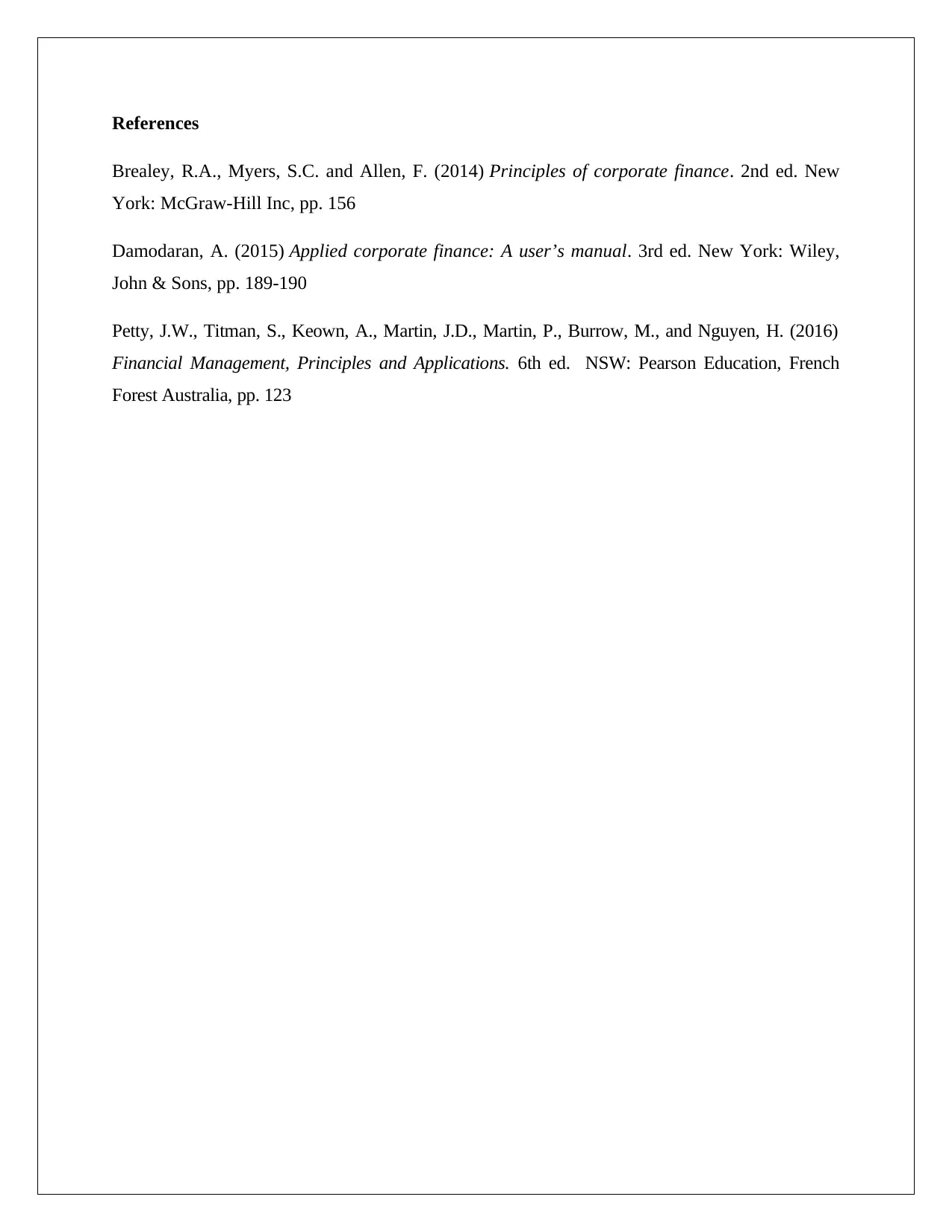
References
Brealey, R.A., Myers, S.C. and Allen, F. (2014) Principles of corporate finance. 2nd ed. New
York: McGraw-Hill Inc, pp. 156
Damodaran, A. (2015) Applied corporate finance: A user’s manual. 3rd ed. New York: Wiley,
John & Sons, pp. 189-190
Petty, J.W., Titman, S., Keown, A., Martin, J.D., Martin, P., Burrow, M., and Nguyen, H. (2016)
Financial Management, Principles and Applications. 6th ed. NSW: Pearson Education, French
Forest Australia, pp. 123
Brealey, R.A., Myers, S.C. and Allen, F. (2014) Principles of corporate finance. 2nd ed. New
York: McGraw-Hill Inc, pp. 156
Damodaran, A. (2015) Applied corporate finance: A user’s manual. 3rd ed. New York: Wiley,
John & Sons, pp. 189-190
Petty, J.W., Titman, S., Keown, A., Martin, J.D., Martin, P., Burrow, M., and Nguyen, H. (2016)
Financial Management, Principles and Applications. 6th ed. NSW: Pearson Education, French
Forest Australia, pp. 123
1 out of 5
Related Documents
Your All-in-One AI-Powered Toolkit for Academic Success.
+13062052269
info@desklib.com
Available 24*7 on WhatsApp / Email
![[object Object]](/_next/static/media/star-bottom.7253800d.svg)
Unlock your academic potential
© 2024 | Zucol Services PVT LTD | All rights reserved.



